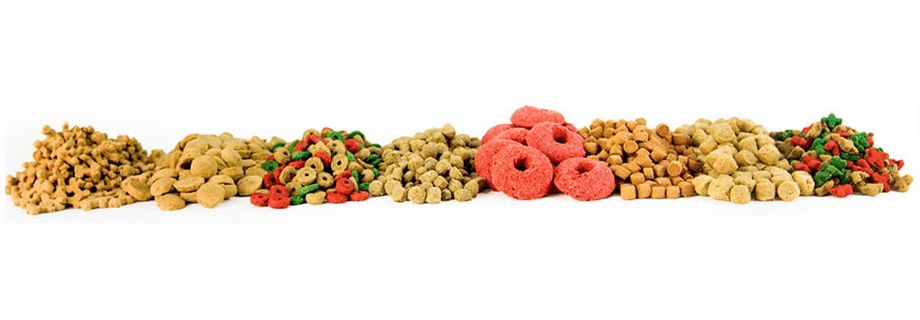Process Flow: Shaped Feeds

The popularity of producing shaped products and feeds is increasing. This includes pet foods, fish feed, and treats. While end products are vastly different, inputs determine the final product and the process to produce them is relatively the same. Use this as a guide to determine the needs and requirements for shaped products extrusion.
Individual ingredient preparation/ product proportioning
Products start with a recipe or formulation based on the final product characteristics and application and formulations are best determined by a nutritionist. Several ingredients go into a formulation and can be purchased pre-ground ready for proportioning or plants can process the individual ingredients themselves. Raw materials are weighed individually and placed into a bin or the bin is on load cells so final weights are accounted for as ingredients are added and proportioned correctly.
Size reduction/sifting
Once proportioned, ingredients are ground to the same size to ensure uniform material flow and delivery to the extruder. Large size variations cause fluctuations in extruder performance and materials need to be ground small enough so they do not plug the die. Finer grinds may be necessary depending on final product appearance. Smaller dies such as 2mm and below will require the product to be sifted to ensure the die does not get plugged during operation. A sifter is used to separate out materials that are just right or too large to extrude. These “overs” are rerun though the mixer.
Mixing/micro ingredient addition
After grinding, all materials are mixed together to ensures a homogenous mix. Micro ingredients can also be added at this time.
Preconditioning/Extrusion
The heart of the system is the dry extruder. In shaped products, preconditioning ensures starch pre-gelatinization and product moisture content for proper extrusion. Steam and water are added at this stage while internal paddles mix the product and convey it to the extruder. The dry extruder applies heat and pressure to ensure proper cooking. The process is designed to ensure a properly cooked and formed product exits the cutterhead. A trained operator is required to know how to run the extrusion system to make the correct final product.
Drying/Cooling
Once extruded, the moisture content of the product can be 18% or more, so the product needs to be dried and cooled. Steam or gas heated belt dryer/coolers are typically used. Heat dries the product, but cooling air is needed so the product is not too hot causing condensation and leading to spoilage.
Sifting
Once dried and cooled, the product should be sifted to remove fines from process handling and recycled back into the system. Removing fines yields a better looking final product and can aid in fat coating.
Fat coating
Applications, such as pet food and high oil fish feed, require additional fat to be added. The key is to sift prior to coating, otherwise the fines collect the valuable oil and ball together into an unusable product.
Bagging
The product is bagged for final distribution and storage.
While the process is similar among different products, it’s the details that determine the final results. The exact flow will vary depending on the final product requirements, but overall, this approach works well for most applications. Knowing how to account for your specific application will determine your success. Our team can assists you with a feasibility analysis, nutritional information, full-plant layouts and purchasing of ancillary equipment, funding and sourcing of raw ingredients. Our main goal is to help you develop optimized products to create a successful business.

